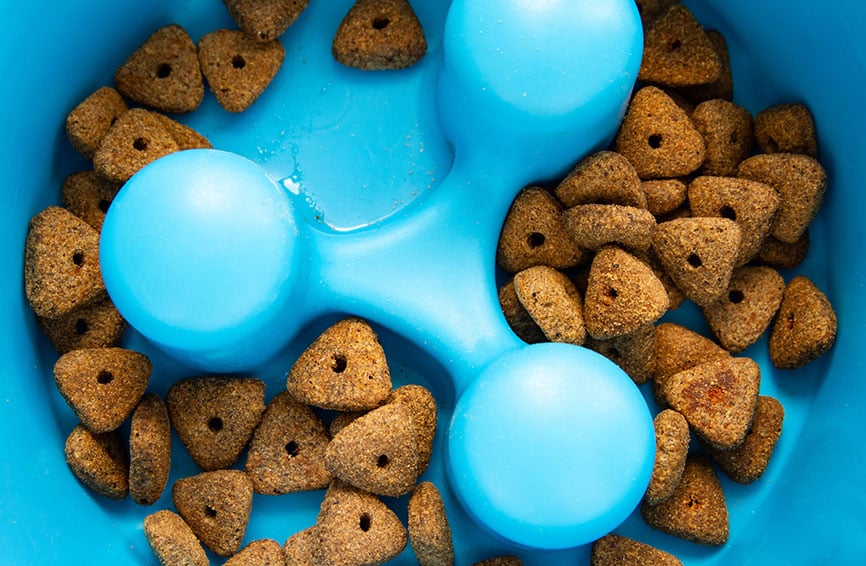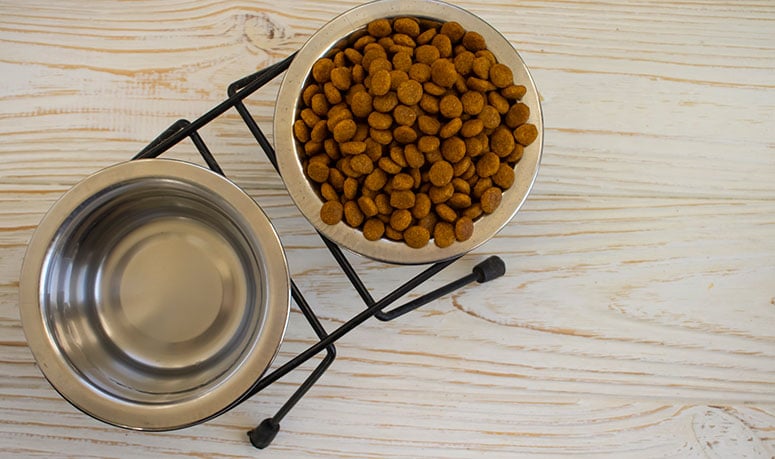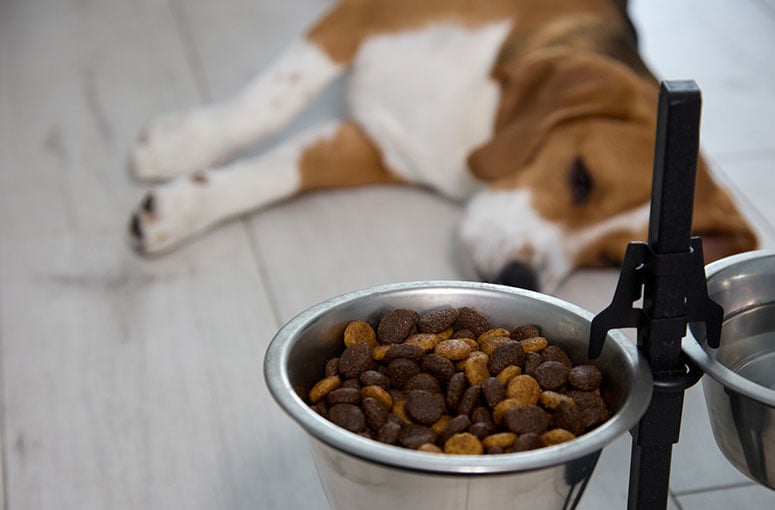Key Takeaways
- Eating too fast can put your dog or cat at risk of choking, vomiting and gastrointestinal discomfort. One solution for over-eager eaters is a slow feeder bowl that puts some obstacles in the way.
- Some dogs may benefit from a raised or elevated bowl, which is better for their spine.
- Both dogs and cats need access to clean, fresh water. A pet water fountain can make it easy to ensure pets are hydrated.
Table of Contents
If your pet is a fast eater, has digestion issues, or doesn’t drink enough water, consider a special type of food and water bowl for your dog or cat.
Slow feeder bowls for dogs and cats
When it comes to mealtime, some dogs are far too eager. They swallow mouthfuls of kibble without chewing and they seem to eat every meal as though it’s their last. It’s a positive sign for your dog to have a healthy appetite, but chowing down too quickly can cause a health issue.
Eating too fast puts your dog at risk of:
- Choking
- Vomiting
- Gastrointestinal discomfort
- Gastric dilatation and volvulus (GDV or bloat), a potentially life-threatening condition
Also, when a dog scarfs down his food, he won’t immediately get those “full” signals from his stomach. This could lead to stealing food from other pets, begging, and obesity due to overeating.
Fortunately, now there are dog bowls that help slow down fast eaters. They present obstacles for your dog to work around, preventing him from taking huge mouthfuls of food at a time, and reducing the risks of the issues mentioned above.
Dogs aren’t the only pet that may scarf food. Cats, too, can be fast eaters and might benefit from a slow feeder bowl. You can simply purchase a smaller slow-feeder bowl or puzzle feeder designed specifically for a cat.
How slow feeder bowls work
Slow-feeder pet bowls come in various shapes and sizes. Their common feature is raised areas or obstacles that force them to eat slower.
Besides the physical health benefits of slower eating, some slow-feeder bowls can provide your pet with mental stimulation. Pets must put in more effort and concentration while eating from these puzzle feeders, which can engage their minds and support their natural scavenging behavior. Keeping pets mentally active promotes their overall well-being. It will also keep them occupied longer, so they spend less time lying around bored while their pet parent is gone. Some slow feeders even provide a bit of exercise for your pet as they move around to access the food.
Introducing your pet to a slow-feeder bowl
If you’re thinking about getting a slow-feeder pet bowl for your pet, there are a few essential things to consider. First, ensure you choose a bowl suitable for your pet’s size and eating habits. Some pets may require a more challenging bowl than others. Dogs with short snouts will need a shallower bowl.
Introducing the bowl gradually and slowly is advisable since some pets may be hesitant to try a new type of bowl. Begin by offering the bowl alongside their regular bowl and gradually increase the amount of food you put in the slow feeder bowl until they are eating all their meals from it. Your pet can learn to enjoy their new bowl and experience its benefits with a little patience and training.
What kind of food works in a slow-feeder bowl?
Slow-feeder bowls are primarily used for kibble, as dry food does not require much clean-up. However, some pet parents use it for wet food or a combination and even freeze the bowl to extend the feeding time. Licking is soothing for pets, so they may find the frozen food consumption relaxing, and it will certainly slow them down substantially. If you use wet food, clean all the crevices of the bowl thoroughly after feeding time.
The best slow feeder bowls:
If you want to try one for your dog, these five slow-feeder bowls are some of the best options.
Outward Hound Fun Feeder Interactive Dog Bowl
$9.95-$19.99
Outward Hound’s interactive bowl is available in three different styles, each of which comes in two size options. That means you can pick your favorite style or buy all three to keep your pup on his toes. They are dishwasher-safe in the top rack. Cons: A clever dog might be able to figure out how to flip it over.
Dogit Go Slow Anti-Gulping Dog Bowl
$5.21-$10.99
The dishwasher-safe and budget-priced Dogit bowl is available in four colors and four sizes from x-small to large, so you can find the perfect fit for your pup. Cons: For eager eaters, this style of bowl may not present enough obstacles.
Northmate Green Interactive Dog Feeder
$35.95-$40.71
Less of a bowl and more of an interactive feeding tray, the green feeder features “blades of grass” of varying heights for a unique challenge. It’s dishwasher safe, comes in two sizes, and its wide, shallow base with gripping rubber feet make it difficult to tip over. Cons: Due to the taller grass blades, this feeder style may not be right for all muzzle shapes and sizes. It’s also more expensive than other options.
OurPets DuraPet Slow Feed Premium Stainless Steel Dog Bowl
$11.95-$22.95
This dishwasher-safe bowl features a skid-proof bonded ring on the bottom and comes in three sizes. Stainless steel is always an excellent choice for pet food bowls because it doesn’t harbor bacteria. (Plastic bowls become scratched over time, creating crevices for bacteria to build up.) Cons: The simple design may not be enough of a challenge for eager gobblers.
JW Pet Skid Stop Slow Feed Dog Bowl
$4.04-$8.74
A popular and inexpensive option, the JW Pet bowl is made of heavy-duty plastic that is dishwasher safe and features a rubber base to prevent sliding. This bowl comes in three sizes and a variety of colors. Cons: The design may not be intricate enough to slow down all dogs.
Petstages Kitty Slow Feeder Cat Bowl
$7.99-$9.99
If you want a slow feeder bowl specifically designed for cats, the inexpensive Petstages bowl is right-sized for a cat, holds up to ¾ cup of wet or dry food and can go in the dishwasher.
Bonus hack: If you’re not ready to commit to a purchase, you can start by simply putting a large clean rock or other safe obstacle in your dog or cat’s bowl with his food to help slow down his eating. Just make sure it’s too big to swallow.
Elevated pet bowls
Another unique type of food or water bowl for dogs or cats is an elevated bowl or raised bowl.
Larger dogs may have to strain to reach a bowl on the ground, which can affect their digestion or be uncomfortable. Raising the food off the ground can make it easier for your pet. The ergonomic design of elevated pet food bowls can be especially helpful for older pets or those with arthritis or spinal problems.
Another advantage of the raised bowls is that they help keep the feeding area cleaner. While food may fly out of any bowl, the raised bowls make the debris easier to see and clean up. The bowls are also held firmly in place so they don’t slide around or get tipped over.
Elevated pet food bowls may not always be desirable or helpful, especially for tiny pets or those that are at risk for Gastric Dilatation and Volvulus (GDV) or bloat.
If you need help determining whether an elevated pet food bowl is right for your pet, consult your veterinarian.
The best elevated bowls
The best elevated dog bowl sets have anti-slip feet to prevent the platform from sliding. Here are a couple of options that are highly rated by pet parents:
HTB elevated dog bowls – for medium to larger dogs
Available in sizes from 4” to 14“ above ground, this sturdy wooden stand comes with two stainless steel bowls and anti-slip pads around the bowl and bottom of the frame. Pet parents rate it highly for sturdiness and it’s easy to clean.
Pawfect Pets 4” elevated dog bowl – for small dogs or cats
$34.95 on Amazon.com
This simple but attractive-looking bowl stand is made from a sustainable bamboo frame and comes with four stainless steel bowls. Anti-slip silicone holds the feeder in place.
URPOWER elevated dog bowls – adjustable
$29.99 on Amazon
If you have multiple pets, have a growing puppy or are unsure of the ideal height for an elevated dish, the URPOWER adjustable raised dog bowl would be a good choice. The metal stand, available in black or shades of grey, is adjustable between 3.2” to 11.8” and comes with stainless steel bowls. The legs also fold for compact storage.
Pet water fountains
You probably know that it’s essential for your pet’s health to always have fresh drinking water readily available, especially during the hotter months. Many pet parents buy water fountains for their cat or dog to help with hydration.
Dogs are pretty good at regulating their own water intake. A healthy dog drinks when thirsty and stops when they’ve had enough. As long as you provide access to clean, fresh water, they’ll do the rest. Generally, dogs need about one ounce of water per pound of body weight daily; for reference, a 40-pound dog would need about five cups of water daily.
Cats need less water than dogs (probably because they have evolved from desert-dwelling ancestors), but they still always need fresh drinking water available. Individual water needs for all pets will vary based on activity level, diet, health, and the weather.
One way to help keep your pets hydrated is to invest in a water fountain explicitly designed for them. A pet water fountain has a large reservoir and circulates and filters water to keep it fresh.
Water fountains for cats can be especially beneficial as they are designed to get most of their water from their food and are less likely to drink enough water than dogs, Dr. Michael Lund, a veterinarian of the American Society for the Prevention of Cruelty to Animals (ASPCA), told the New York Times.
“Cats typically maintain themselves in a mildly dehydrated state,” Lund said, “And kidneys function to remove wastes from the body while retaining as much water as possible.” He added that using a water fountain can help encourage hydration, reducing the burden on your cat’s kidneys.
Here are some of the benefits to using a water fountain for pets:
- It can encourage your pet to drink more water, essential for their overall health.
- The water’s sound and movement can entice pets and make them more likely to drink, especially if they tend not to drink enough.
- It can help filter out impurities from the water. Many fountains come with replaceable filters that can filter out any debris or contaminants, ensuring your pet is drinking clean, fresh water.
- Fountains can be a great option for pet parents who are frequently away from home.
- It can save time by only needing to fill it once or twice a week, but there is a bit of maintenance with changing filters and cleaning it.
One downside is the cost – the filters in some fountains may need to be replaced monthly, which can add to the cost of owning one. Some pet water fountains can also be noisy and difficult to clean.
Here are some water fountains that are highly rated:
Catit Flower Plastic Cat Fountain, 100-oz
$27-$34.43, filter replacement – $20 for a pack of five.
New York Times reviewers called this their favorite pet fountain in 2022 because it has a large water capacity, is easy to clean, and has a low noise level. It comes in plastic or stainless steel options, has a circulating system to cool and aerate water, and the drinking bowl is dishwasher safe. It works for cats or small dogs.
Pioneer Pet Stainless Steel Fountain Raindrop Design, 60-oz
$44.99, filter replacement – $12.99 for a pack of four.
The New York Times reviewers like this fountain for its attractive metal design, which is heavier and harder to knock over than plastic versions. They said it emits a persistent low hum, regardless of the water level. It comes in 60- and 90-ounce sizes, is dishwasher-safe, and is easy to clean.
Remember: If your pup or kitten drinks water excessively, contact your veterinarian because it could indicate an underlying health problem.










